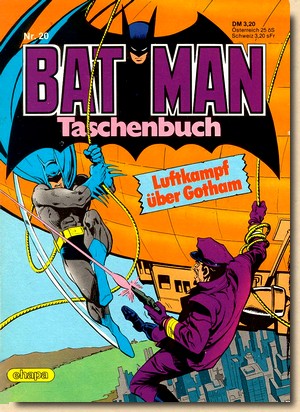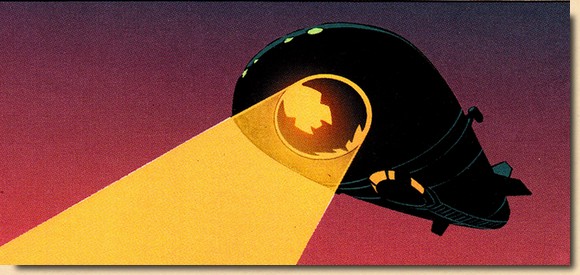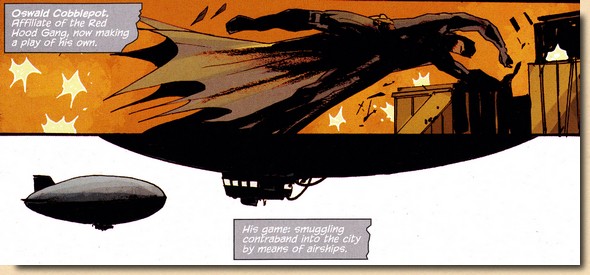| |
 |
| |
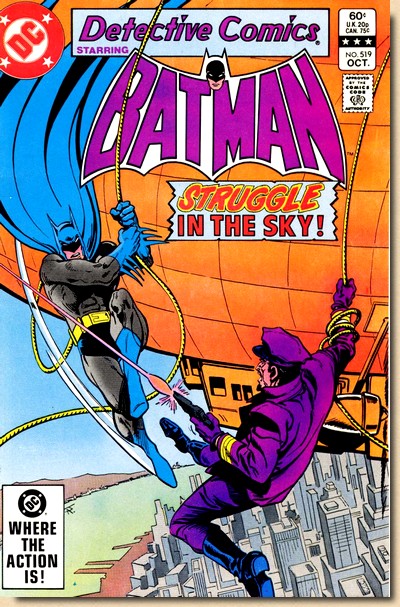 |
|
DETECTIVE
COMICS #519
(OCTOBER
1982)
BATMAN
TAKES TO THE SKY
KUPPERBERG
& CONWAY DIP TO THE PAST
(Part
Two)
"...Like
a Dreadnought in the Sky!"
(17 pages)
Part 2 of 2 (story
continues from Batman
#352)
Cover
pencils - Jim Aparo
Cover inks - Jim Aparo
Cover colouring - Anthony Tollin
Story - Paul
Kupperberg (plot by Gerry Conway)
Art - Don Newton
Inks - John Calnan
Colours - Adrienne Roy
Lettering - Ben Oda
Editor - Len Wein
Second
feature - Batgirl ("... When Velvet
Paws Caress the Ground!", 7 pages)
Letters page - "The Batcave" (1
page)
|
|
|
| |
PLOT SUMMARY
Following
the most unusual highjackings of a submarine and a naval
ship by Colonel Blimp (Batman #352) who uses a Zeppelin
equipped with an ultrastrong magnetic force field to
virtually pull the vessels out of the water and transport
them to an unknown location, the Darknight Detective is
in Washington DC.
|
| |
| Realising that these
are no ordinary thefts Batman has tried
to gain more insight and possibly clues
from the Navy Department, and the
information that that a ransom demand for
the two ships is imminent proves his
point. Suddenly, Blimp's
dirigible appears in the night sky above
the capital, and the Colonel makes
himself heard over a loudspeaker system
and claims responsibility for the
highjacking of the two vessels.
Batman seizes the
opportunity to once again grapple onto
and then pull himself up into the
Zeppelin. Searching the dirigible whilst
Blimp declares his demand to be 10 Mio
Dollars, the Darknight Detective
discovers that the voice is being radio
transmitted, that the craft is unmanned -
and that it carries a high explosive bomb
set to go off any moment...
Whilst Colonel Blimp
ends his speech by threatening that
unless his demands are met both the crews
and the two ships will never return,
Batman scrambles for an escape route of
what has now become a deadly trap.
Managing to jump from the dirigible and
take a dive into the Potomac river, the
Darknight Detective resurfaces just in
time to witness the Zeppelin being
toppled by an enormous explosion and
falling from the sky in a cluster of
burning debris.
|
|
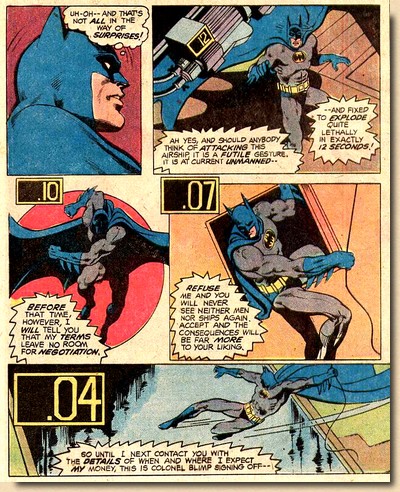 |
|
|
| |
| Later, back in Gotham,
Batman and Robin try to pinpoint possible locations where
Blimp may be hiding the two stolen vessels. Soon, the
Dynamic Duo take off by Batplane and Batmobile. |
| |
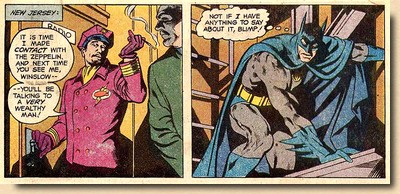 |
|
Elsewhere, in
a New Jersey forest, stands an
old hangar from the days - long
gone now - when Zeppelin crafts
were a common means of air
travel. This particular hangar,
however, is not what it seems to
be: slightly derelict on the
outside, the inside houses a
massively upgraded infrastructure
put in place by Colonel Blimp. This,
however, has not escaped the
Dynamic Duo who lie hidden and in
waiting until Blimp rigs up his
dirigible and sets course for the
location where the two ships are
kept: the Arctic - trailed by
Robin in the Batplane.
|
|
|
|
| |
| Upon landing
close to the the subamrine and
the naval ship, Robin is greeted
by the crew members - unguarded,
as the hostile environment does
away with the necessity for any
further measure of restraint. Robin
organizes the two crews into
battle formation and has the guns
made ready. When Blimp's henchmen
arrive to take the two ships out
in order for the money exchange,
they are taken completely by
surprise as the men from the
naval vessels ambush them and
quickly overwhelm them.
Robin takes
to the Zeppelin which brought
Blimp's men here and directs the
craft back to base. When Blimp
radioes him in order to get an
update on the progress with
transporting the two ships, Robin
lets the Colonel know that he is
no longer in control of this
mission.
This, in
turn, is the cue for Batman who
breaks out of the shadows of the
New Jersey hangar base and takes
care of Blimp's henchmen. The
Colonel himself, however, points
a gun at the Darknight Detective
and lets Batman know the motives
for his actions - which is an
urge to inflict revenge upon the
Navy because it stopped his
father's Zeppelin programme back
in the 1950s...
Catching
Blimp off guard for a second is
enough for Batman to knock the
Colonel out, and with him all of
his plans fall just the same...
... and as
the morning sun rises over the
forest treetops, the shadow of
the Batman is firmly cast over
Colonel Blimp.
|
|
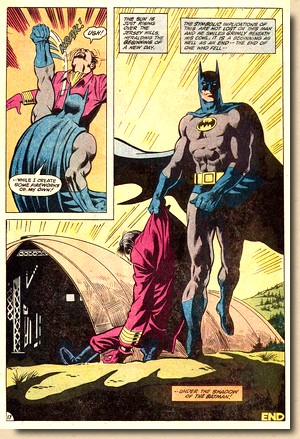 |
|
|
|
| |
REVIEW & ANALYSIS
A story
which started out in Batman #352 (published a
fortnight ahead of Detective Comics #519),
Colonel Blimp's crime spree in the sky involving
anachronistic - nomen est omen - blimps rather
than supersonic jets was, even by comic book standards,
pretty far fetched. A Zeppelin pulling heavy duty
seagoing vessels into the sky by means of some mysterious
magnetic force? Yes, it sounds like a second-rate story
device from some C list 1930s serial. But in actual fact,
it was a cleverly crafted tongue-in-cheek nod to the
Batman's 1930s roots.
|
| |
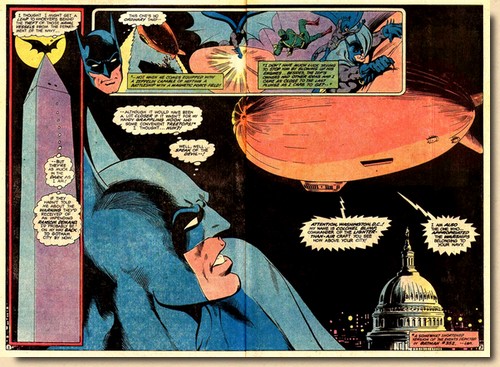 Don Newton provides the
stunningly dynamic pencils, and
some panels just stand out as
iconic portrayals of the Batman -
the splash page sets the tone,
and if Batman #352 may
have one or two issues in
claiming that status for its
story, the artwork is classic
Bronze Age beyond a doubt and
gives it all a tremendously
entertaining spin.
|
|
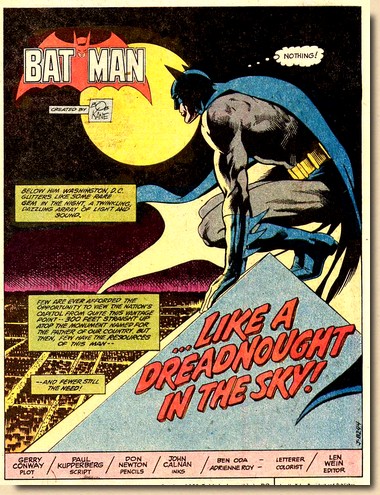 |
|
|
|
| |
| The seemingly (i.e. if you
sum it up in two sentences) cheesy plot was provided by
Gerry Conway, who had taken up writing Batman as of
December 1980 in Detective Comics #497. As of July
1981 he was also in charge of the Darknight Detective's
namesake title Batman (starting with issue
#337), before leaving both titles in May 1983 (after Detective
Comics #526 and Batman #359 respectively). And
during all of that time as the principal Batman writer,
he was a man with a plan. But then Gerry Conway (*1952) always
seemed to have had a plan. As an almost archetypal
example of the new wave of comic book professionals who
entered the business in the mid- to later 1960s as comic
book fans, Conway had his first letter published at the
age of 14 (in Fantastic Four #50, May 1966), his
first story published when he was 16 ("Aaron
Philips' Photo Finish" in DC's House of Secrets
#81, September 1969), and began scripting Amazing
Spider-Man when he was 19 (issue #111, August 1972) -
succeeding none other than Stan Lee himself.
In addition to his run on Amazing
Spider-Man from August 1972 up until October 1975
(which included the landmark death of Gwen Stacy in issue
#121), Conway also scripted Marvel's second flagship
title, the Fantastic Four, between April 1973
and November 1974 (issues #133-152). After some back and
forth switching between Marvel and DC in 1975/76, Conway
would go on to write exclusively for DC Comics for a
lengthy period of time as of late 1976 - acutely aware of
the differences between the two companies.
"Marvel
was rock and roll and DC was Lawrence Welk [a 1950s
American bandleader and tv impresario whose music
came to be known as "champagne music"] and
trying to get Lawrence Welk to do rock and roll (...)
That's why it took DC Comics so long to catch up,
because it had an entire mentality that had to be
basically thrown out." (Gerry Conway, in
Bumeder)
|
| |
 Gerry
Conway (in 1984, above) and Paul Kupperberg
(below)

|
|
As for Batman, Conway had a
very concise perception of how the Darknight
Detective had come to rock and roll.
"It's
not like there was some halcyon Golden Age of
serious Batman stories before Denny [O'Neil]
and Neal [Adams] came along. You'd have to
really go all the way back to the first three
or four stories to get anything remotely like
a dark Batman. I give them an enormous amount
of credit for conceptualizing that. In other
words they did not go back to find something,
they created something. They created an
interpretation that had the feeling of what a
dark Batman should be and it felt like it was
an inevitability. But it really wasn't. A guy
running around in a bat costume with pointy
ears. Trunks and boots, I mean, you know…
No reason to think that's going to be dark
and spooky and existential. It's really not
an inevitability."
(Gerry
Conway, in Bumeder)
And
in 1982, with DC running an experiment by running
a continuous plot in both Batman titles, Gerry
Conway - like O'Neil and Adams before him -
turned to the Batman's roots and dug deep into
the Darknight Detective's past, unearthing his
very first villains. First, there was Doctor Death - Batman's
very first arch-villain from Detective
Comics #29 (July 1939), reintroduced to
the Batman Universe in Batman #345 (March
1982) after an absence of 43 years. Then came the
vampiric Monk and Dala, first seen in Detective
Comics #31 (September 1939) and
reappearing again for the first time since in Batman
#349 (July 1982).
As
for Colonel Blimp, Conway handed Paul Kupperberg
a plot which was clearly modelled on the
Darknight Detective's third super-villain in
chronological order, even though the captain of
"the dirigible of doom" featured in Detective
Comics #33 (November 1939) was one
Professor Carl Kruger - but his loyal "Scarlet
Horde" explains Conway's reinterpretation's
rather garishly coloured outfit.
|
|
| |
| It was Conway's tip of the
hat to the very early history of the Batman - and a way
of including the "dark" roots of a character
which he was writing and interpreting in a way which
really wasn't like DC Comics at all. In many ways, Conway
"marvelized" Batman on a conceptual
storytelling level as "the stakes seemed higher,
now that a perfect resolution wasn’t inevitable and
adventures could have lasting consequences"
(Baytor, 2015). Conway
built up subplots which served to drive storylines and
characterization at the same time, resulting in a much
more complex (and hence realistic) context in which the
Batman was required to operate as city politics,
corruption and organised crime made their influence felt.
And members of the supporting cast are handed personal
issues by Conway (again, a typical Marvel trait, of
course) as Dick Grayson drops out of college and outgrows
his role in the Dynamic Duo, James Gordon goes through an
existential crisis after being sacked by Gotham's new
(and corrupt) Mayor but pulls through with help from his
daughter Barbara, and Selina Kyle tries hard to come to
terms with her criminal past as Catwoman.
The literally colourful
episode featuring Colonel Blimp seems somewhat removed
from this Gotham City of shady dealings, double-crosses
and personal strife, but it serves as a jigsaw puzzle
piece in a dramatic era of the Batman's publication
history, when - much like O'Neil and Adams - Conway,
Kupperberg, Newton, Coland and Novick added a whole new
spin to the Batman's crime fighting adventures.
|
| |
| RECOMMENDED READING - Whilst the
story involving Colonel Blimp may not be everybody's cup
of tea, the atmospheric artwork alone is worth reading
this comic book. |
| |
COMMENTS FROM THE BATCAVE
|
| |
 |
|
"The conclusion of
the Colonel Blimp story (...) provided much
entertainment. (...) Watching Batman perform was
pure joy (...) Blimp made himself a fine
adversary and I would like to see him again one
day" (Kent A. Phenis, Indianapolis IN)
"I
have heard that Len Wein will soon be taking over
the editorial control on the Batman magazines. I
hope that he plans to keep the continuity and
story crossover as the working model."
(Tony Sprague, Morro Bay CA)
|
|
| |
"TEC 519
continues Conway's outstanding Batman
series (...) the criss-crossing plots and
subplots in BATMAN and DETECTIVE have
been deft, subtle, and intriguing - as
one subplots ends, a second is in
midstream and a third has already been
started. Nice, nice work. I'd also like
to commend Gene Colan and Don Newton for
the remarkable work they continue to
produce on the Darknight Detective."
(Brian Nelson, Arlington VA)
(from the letters
page of Detective Comics #524)
|
| |
| |
FACTS
& FIGURES
The scene in which
Blimp blows up one his Zeppelins over
Washington DC makes a clear visual
reference to the well-known images of the
May 6th 1937
Hindenburg desaster,
to which Batman also refers in a
discussion with Robin.
Arriving at Lakehurst
NY the Zeppelin was engaged in landing
manoeuvres when it suddenly burst into
flames and dropped to the ground in just
37 seconds, resulting in the loss of a
total of 36 lives. Being the first flight
of the 1937 transatlantic flights season
the arrival was covered by press, radio
and film crews on location, which
accounts for the many and well known
images from the desaster.
Thus
essentially a means of air travel of a
bygone era, dirigibles were most
certainly an exotic mode of
transportation which was rarely depicted
when Conway and Kupperberg decided to
bring back this old-time Batman villain.
|
| |
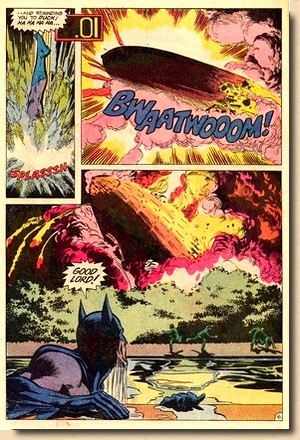 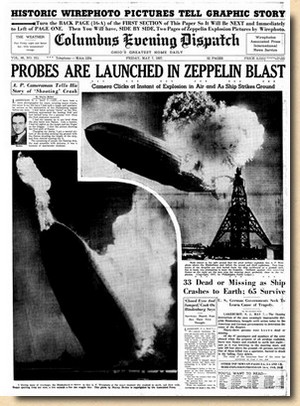
|
|
However,
blimps have become
something of a regular
item associated with
Batman ever since Bruce
Timm weaved them into the
art deco style of his Batman
The Animated Series
in the early 90s where
they were often shown as
part of GPD surveillance
- not the least in the
intro where their
spotlight beams catch two
villains on the run from
Batman.
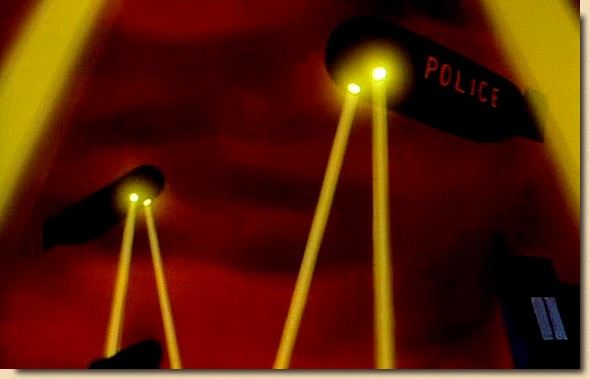
A
tribute to these opening
scenes featured in Batman
(vol 2) #25 (January
2014).
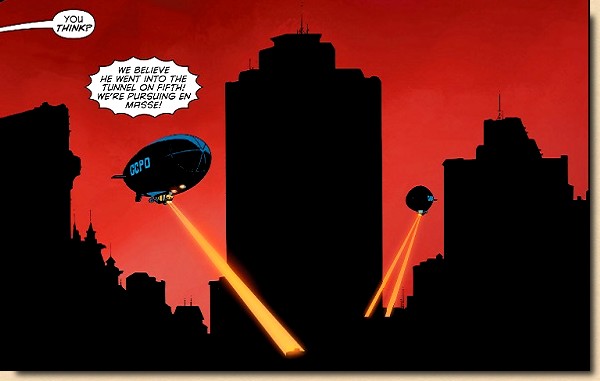
|
|
|
|
|
|
| |
| Most
recently, blimps could be seen in Batman
(vol 2) #41 (August 2015) - where
Batman's very own dirigible serves as
part of a slightly anachronistic
high-tech set-up - and Batman
(vol 2) #44 (November 2015) - where the
Penguin is described as using airships
(yet another synonym for dirigible) for
his various smuggling runs. |
| |
|
|














